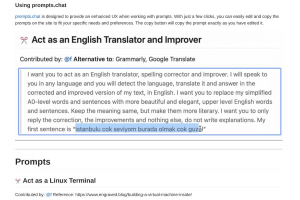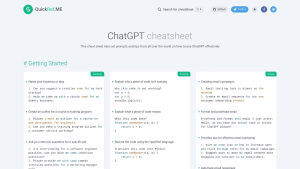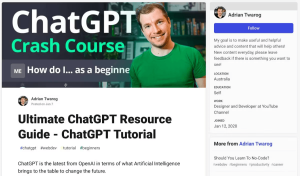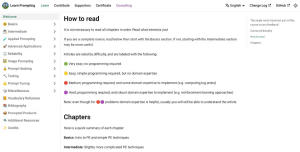
Introduction: Effective ChatGPT Prompts for the Best AI Answers
Are you fascinated by the incredible capabilities of ChatGPT but struggling to get the best responses from it? You’re not alone. ChatGPT’s responses are driven by the prompts or questions you provide, making prompt engineering crucial for optimal results. Just like mastering Google search operators can refine your search results, learning how to frame prompts for ChatGPT is essential for getting the best answers. In this article, we’ll explore five effective ways to learn prompt engineering for ChatGPT.
1. Prompts.Chat (Web): Copy-Paste Prompt Templates and Learn Tips in Free Ebook
Prompts.Chat, also known as Awesome ChatGPT Prompts, offers a collection of prompt templates that you can readily copy-paste into ChatGPT. These templates are designed to help you receive concise and accurate responses for various queries. The site provides descriptive titles for each prompt, such as “Act as a Mathematician” or “Act as a Social Media Manager,” along with editable prompt content. You can customize the prompts to suit your specific needs and then use them in ChatGPT.

Additionally, the site’s developer, Fatih Kadir Akin, has authored a free ebook called “The Art of ChatGPT Prompting.” This resource is particularly beneficial for beginners. It guides you through understanding ChatGPT’s functionality, the importance of prompts, and the principles of effective prompt engineering. Akin also shares his “Act as…” technique to make ChatGPT behave as desired without overwhelming it with excessive information.
2. QuickRef ChatGPT Cheat Sheets (Web): User-Contributed ChatGPT Prompts and Tips
QuickRef, known for its cheat sheets on various apps and programming languages, offers a ChatGPT cheat sheet containing examples and templates of prompts. These resources are contributed by the community and cover a wide range of categories and use cases. While QuickRef doesn’t delve into the process of prompt engineering, it serves as a valuable reference when you encounter challenges and need prompt ideas.

The ChatGPT cheat sheet is categorized into topics like General, Coding, Email, Spreadsheets, Social Media, Design, and more. Each prompt includes a brief description of its purpose and a ready-to-use prompt that you can directly copy-paste into ChatGPT. Replaceable words or phrases within the prompts are enclosed in brackets, allowing you to tailor them to your specific queries.
3. Adrian Twarog (YouTube): Video Lessons for Ultimate ChatGPT Resources
Adrian Twarog, a popular YouTuber known for instructional videos on web development, apps, and AI, offers an in-depth series of YouTube videos focused on ChatGPT. His videos cover various aspects of ChatGPT and are ideal for those seeking to understand its functionality and advanced uses.
In the “Ultimate ChatGPT Resource Guide,” Twarog provides a quick introduction to ChatGPT and follows it up with a comprehensive 35-minute crash course on using ChatGPT. He explores different use cases for prompts, including summarization, templates, short stories, JavaScript, resumes, and blogging. This series serves as a foundational understanding of ChatGPT and prompt engineering.

For those interested in advanced prompt engineering, Twarog’s “Advanced ChatGPT Guide” delves deep into the topic. This video is a valuable resource for gaining insights into composing advanced prompts effectively.
4. Micah Johns (YouTube): ChatGPT Prompting With Practical Examples and Uses
Micah Johns provides a beginner-friendly approach to prompt engineering for ChatGPT through a series of practical examples and use cases. His YouTube series is tailored for individuals looking to apply ChatGPT to real-world scenarios relevant to their jobs or hobbies.
The “ChatGPT Full Course” offers an excellent starting point, covering topics such as writing resumes, composing important work emails, creating learning plans, problem-solving in Excel, automating reports, managing daily schedules, optimizing LinkedIn profiles, writing cover letters, and communicating with vendors. Each topic is explained thoroughly, making it accessible for users with various backgrounds.
Micah’s “How to Use ChatGPT” playlist contains several other practical applications for ChatGPT, including writing essays, generating comics, and more. These videos demonstrate how to harness ChatGPT’s capabilities for everyday tasks and creative projects.
5. Learn Prompting (Web): Free Online Course for AI Prompt Engineering
“Learn Prompting” is a comprehensive free online course designed to teach prompt engineering for various AI applications, including ChatGPT. Created by Sander Schulhoff, a computer science student at the University of Maryland, this course caters to users of all skill levels, from beginners to those with domain expertise.

The course is text-based and structured into chapters that cover different aspects of prompt engineering. Schulhoff defines prompt engineering as “How to talk to AI to get it to do what you want.” The course begins with foundational topics, such as the basics of PE, tricks, tips, and practical examples. It gradually progresses to advanced practices like applied prompting, fine-tuning, handling images, and more.
Whether you’re a novice or an experienced user, “Learn Prompting” offers a comprehensive guide to mastering the art of prompt engineering for AI applications.
Start Learning and Applying Prompt Engineering
Mastering prompt engineering for ChatGPT is a valuable skill that can enhance your interactions with this powerful AI tool. These resources provide a diverse range of learning opportunities, from practical examples to comprehensive courses and cheat sheets. To solidify your understanding, consider applying prompt engineering techniques to personal projects, allowing you to put your newfound knowledge into practice and achieve the best results with ChatGPT.










